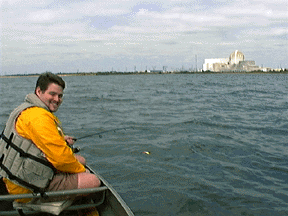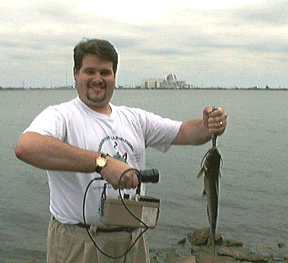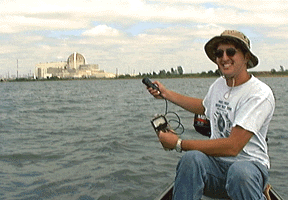Most people have heard of nuclear fission. How about....
Nuclear Fishin!
Our team made a trip down to the Wolf Creek Generating Station in Burlington, Kansas
to see what it was like to catch fish in the shadow of a nuclear reactor.
Most people would
assume that there was widespread contamination in the area surrounding a reactor,
but the geiger counter was unusually quiet during the time we were there.
Even the fish passed the test!

The following is an excerpt from a study titled
"Wolf Creek Generating Station Environmental Radiation Surveillance Report Summary"
July 1997-June 1998
Kansas Department of Health and Environment
Bureau of Air and Radiation Radiation Control Program
RESULTS
Results are reported in the following data tables for the samples taken around WCGS during SFY 1998. Radionuclides detected in the environment surrounding WCGS during SFY 1998 included 228Ac, 7Be, 60Co, 137Cs, 3H, 40K, 226Ra, 125Sb, 89Sr, and 228Th. The isotopes 228Ac, 7Be, 40K, and 228Th are naturally occurring radionuclides common to most sample types. The isotopes 137Cs, 3H, 125Sb, and 89Sr are fission products formed from WCGS nuclear reactor operation. The isotope 60Co is an activation product, also formed from WCGS nuclear reactor operation. A small background component of the 3H (half-life = 12.3 y) and 137Cs (half-life = 30.1 y) activity is due to previous nuclear weapons tests. Small amounts of 3H are also produced naturally from cosmic ray interactions with water vapor in the upper atmosphere. Background levels of 137Cs and 3H are accounted for in control samples and in pre-operational data. The fission and activation product activity levels found to date in the environment surrounding WCGS are not above expected regulated levels and are very small when compared with activity levels due to naturally occurring radionuclides.
The most significant radionuclide present in surface water samples collected in the WCL is 3H, a beta emitter. The highest 3H concentration measured in the WCL during SFY 1998 was 13,355 pCi/R This maximum WCL 3H concentration is 67 per cent of the National Primary Drinking Regulation maximum contaminant level (MCL) of 20,000 pCi/R The water from the WCL is not used as a drinking water source. All other surface water, ground water, and drinking water samples collected in the environs of WCGS during SFY 1998 indicated no radionuclides present attributable to the operation of WCGS.
Algae and sediment samples are excellent indicators for the monitoring of a fission and activation product buildup in the environment surrounding WCGS. AIgae samples have been the best indicators for monitoring the seasonal fluctuations of fission and activation product levels in the WCL. Sediment samples have been excellent indicators for the long term buildup of fission and activation product activity levels in the WCL. The highest fission product activity (other than 3H) during SFY 1998 was 623 pCi/kg-dry 137Cs found in a WCL DC bottom sediment sample. The highest activation product activity observed during SFY 1998 was 1,537 pci/Ci/kg-dry 60Co found in the same WCL DC bottom sediment sample.
Airborne sample analysis showed that no radionuclides attributable to the operation of WCGS were present above the lower limits of detection during SFY 1998. The highest gross beta activity noted was 0.073 pCi/m3, due primarily to naturally occurring 222Rn progeny, specifically the long-lived isotope 240Pb (half-life = 21 y).
Sample analysis of terrestrial vegetation, soil, milk, grain, domestic meat, and aquatic vegetation samplescollected in the environs of WCGS during SFY 1998 indicated no radionuclides present attributable to the operation of WCGS. The isotope 137Cs was identified in some soil samples and a pasturage sample. A control soil sample showed a maximum 137Cs activity of 1016 pCVkg-dry, and a pasturage sample showed a 137Cs activity of 107 pCi/kg-dry. The presence of 137Cs is not attributed to the operation of WCGS.
Sample analysis of edible fish portions collected in the environs of WCGS during SFY 1998 showed that no gamma emitting radionuclides were present due to the operation of WCGS. All edible fish samples collected during SFY 1998 were analyzed for 3H in tissue (fat and water). A total of twenty-seven fish was taken from the WCL during SFY 1998. The highest 3H concentration in tissue was 18,349 pCi/kg-wet found in a composite sample of two Smallmouth Buffalo taken at the WCL ultimate heat sink. Using an ICRP 30 dose conversion factor for ingestion (hE,50) of 6.40E-08 mrem per psi 3H ingested, a standard man consuming 21 kg/y of fish containing 1 8,349 pCUkg 3H would receive a committed effective dose equivalent of 0.02 mrem. The projected dose equivalent is far below the 100 mrem/v regulatory limit set for an individual member of the pubilc. Control samples taken on the Neosho River below JRR showed 3H activity ranging from 6856 pCi/kg-wet to 10,329 pCi/kg-wet. These results are above the LED of 1 ,200 pCi/kg-wet and are an indication of a problem with the analytical technique, scintilIation fluor, chemiluminescence, cross-contamination, or a combination thereof. Radiochemistry Laboratory personel are investigating the problem.
Direct radiation monitoring sites showed no significant changes from preoperational data. The grand yearly average of all sites was 70 mR/y, corresponding to 8 microR/h. The lowest direct radiation levels are found closest to the WCGS. The direct radiation levels on the WCL baffle dikes at the 1,200 m exclusion area boundary are the lowest of any monitored site. The average baffle dike direct radiation level for SFY 1998 was 49 mR/y, corresponding to 6 microR/h. Limestone was used to construct the baffle dikes, and has a lower natural background radioactivity than the original soil present before the construction of the WCL. This effect of construction on the terrestrial component of natural background radiation was noted on radiation surveys conducted around the WCGS site before bringing the initial fuel load on the site. The water from the WCL also acts as an effective shield from terrestrial radiation that was present before lake filling.
Program changes that occurred from SFY 1997 to SFY 1998 are summarized as follows. Milk collection frequency was changed from monthly to quarterly. Surface water sampling below the WCL dam was stopped. The N RC Cooperative Agreement ended effective December 31, 1 997. As a result of dismantling the NRC TED network, four additional sites were added to the State of Kansas TED monitoring network: forward staging area, Coffey County airport, John Redmond Reservoir public use area, and the Coffey County shop. Fish collection efforts at the WCL outlet pool and algae collection efforts at the WCL DC were unsuccessful. No game animals were collected during SFY 1998.
Table II gives summary statistics for data collected by KDHE. Data comparisons were made between KDHE and WCNOC. The ratio of KDHE results to WCNOC results ranged from 0.9 to 7.2.
Return To Main









